Eliminating Spiders Around Homes and Buildings
ENTFACT-623: Eliminating Spiders around Homes and Buildings | Download PDF | En Español
by Michael F. Potter, Extension Entomologist
University of Kentucky College of Agriculture
Many different kinds of spiders live in and around dwellings. Some, such as the cellar spider, construct webs to help entrap their prey. Others, like the wolf spider, are free roaming and make no webs. Most spiders are harmless and in fact beneficial because they prey upon flies and other pests. The majority of spiders have fangs too small or weak to puncture human skin. Those that are capable of biting humans generally will not do so, unless they themselves are harmed or threatened.
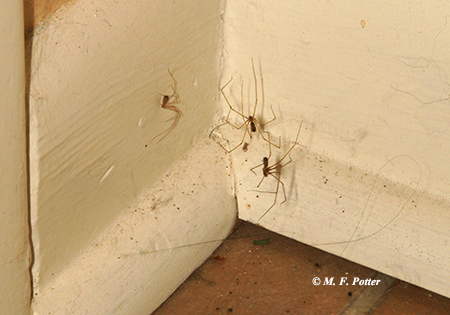
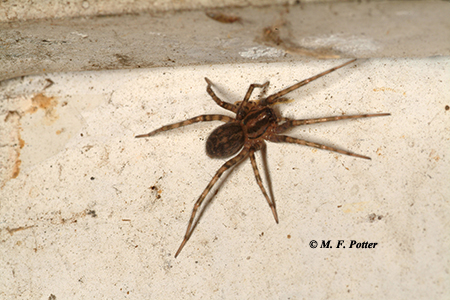
Fig. 1: The cellar spider (above) and wolf spider (below) are common in buildings. Both are harmless.
Of the many types of spiders occurring in Kentucky, only the black widow and brown recluse are potentially dangerous. Nonetheless, many people are unwilling to share their home with spiders— harmful or not. Their webs, fecal spotting, and discarded prey can also become an unsightly nuisance.
The following tips pertain to managing all spiders, followed by information specific to the black widow and brown recluse:
- Routine, thorough house cleaning is the best way to eliminate spiders and discourage their return. A vacuum cleaner or broom effectively removes spiders, webs, and egg sacs. Destruction of egg sacs is crucial since each can contain hundreds of young spiders.
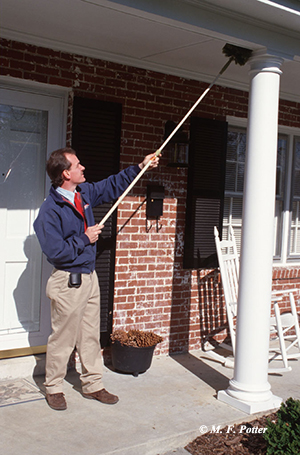

Fig. 2: A broom or vacuum effectively removes spiders, webs, and egg sacs (above).
Destroying egg sacs can prevent emergence of large numbers of young spiders (as shown here; below).
- Spiders prefer quiet, undisturbed areas such as closets, garages, basements, and attics. Reducing clutter in these areas makes them less attractive to spiders.
- Large numbers of spiders often congregate around building exteriors. Moving firewood, stacked items, and debris away from the foundation helps reduce migration indoors. Shrubs, vines and tree limbs touching the house should also be trimmed back since these afford harborage and a convenient bridge to the structure.
- Install tight-fitting window screens and door sweeps to exclude spiders and other pests.
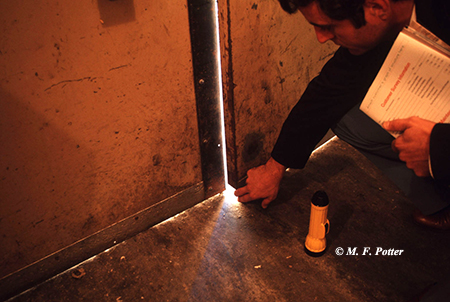
Fig. 3: Gaps under doors are a common entry point for spiders.
- Consider installing yellow or sodium vapor light bulbs at outside entrances. These lights are less attractive than conventional bulbs to night-flying insects, which in turn, attract spiders.
- To reduce spider entry from outdoors, insecticides can be applied as a ‘barrier spray’ around the perimeter of the building. Pay particular attention to door thresholds, garage and crawl space entrances, foundation vents, and the bottommost edge of siding. Products containing ingredients such as bifenthrin, cyfluthrin, deltamethrin or lambda cyhalothrin are effective, but may need to be applied periodically (e.g., monthly or bi-monthly) during warmer times of the year.

Fig. 4: Insecticide sprays can often help deter spiders and other pests from entering homes.
Black Widow Spider- Of the spiders able to inflict a serious bite, the black widow is probably the most well-known. The adult female is about 1/2-inch long, shiny black and usually has a red hourglass pattern on the underside of the abdomen. In some varieties and juvenile spiders, the distinct hourglass marking may be reduced to separate reddish spots on the lower or upper surface of the abdomen.
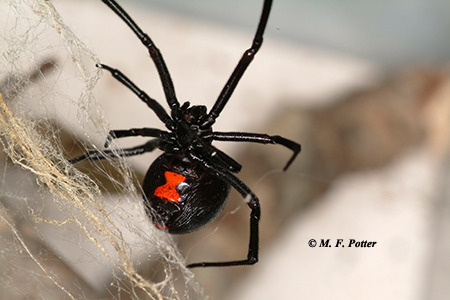
Fig. 5: The black widow can inflict a serious bite and should be treated with care.
Black widows belong to the ‘cobweb’ family of spiders that spin loosely organized webs. Other varieties of cobweb spiders, including the common house spider, are harmless. In Kentucky, black widows are seldom found indoors. They typically dwell outdoors under rocks, boards, or yard debris (e.g., stacked flowerpots). When black widows are discovered in homes, they are usually spotted in vestibules and garages, or at times, sheds and outbuildings.
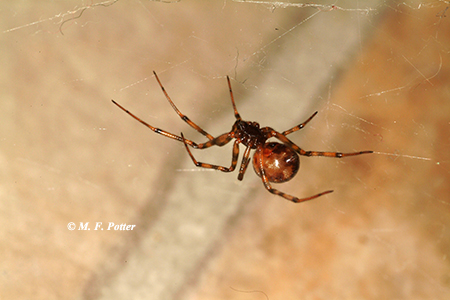
Fig. 6: The common house spider is related to the black widow but is harmless.
Like other spiders, the black widow is timid and will only bite in response to being threatened or injured. People are usually bitten when lifting objects or reaching into areas where a spider is hidden. Black widow venom is a nerve toxin and its effects are rapid. The victim suffers painful rigidity of the abdomen and usually a tightness of the chest. Blood pressure and body temperature may rise, and sweating, localized swelling, and nausea may occur. In rare cases, the victim may go into convulsions 12 to 24 hours after being bitten and die if not given medical attention. First aid for black widow spider bites involves cleaning the wound and applying ice packs to slow absorption of venom. Victims should promptly seek medical attention. Most black widow bites respond to pain medication and muscle relaxants. An antivenin is also available for severe cases.
Brown Recluse Spider- Unlike the black widow, the brown recluse is often confused with other non-hazardous brown spiders. It ranges from a dark cream color to dark brown, with the abdomen darker than the rest of the body. It has a violin-shaped marking on the top, fore-section of the body (thus, the namesake ‘fiddle’ or ‘violin’ spider). Brown recluse spiders also have three pairs of eyes (6 total) rather than the usual eight for most other spiders.

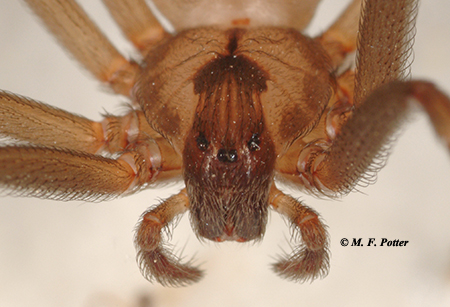
Fig. 7: Brown recluse spiders have a fiddle-shaped marking and three pairs of eyes, arranged in a semi-circle.
The brown recluse roams at night in search of prey and mates. During the day, it usually hides in concealed places, where it may spin a mat-like web. It is shy and will normally retreat if threatened or disturbed. Nonetheless, people are sometimes bitten while putting on a shoe or clothing that a spider has chosen for its daytime retreat. Other bites may occur when a sleeping person contacts a spider that has crawled on the bed. The bite of a brown recluse is usually painless until three to eight hours later when it may become red, swollen, and tender. Later, the red area around the bite may develop into an ulcerous sore. Healing often requires a month or longer, and the victim may be left with a deep scar. Prompt medical attention can reduce the extent of ulceration and alleviate other complications that may develop.
Persons bitten by a spider which they think is a brown recluse should try to collect the specimen and bring it to a qualified individual for identification. Positive identification by an expert will help the physician decide on the appropriate course of treatment.
Controlling Recluse and Widow Infestations
Thorough inspection of cracks, corners, and other dark, undisturbed areas with a bright flashlight will help determine the location and extent of infestations. Both brown recluse and black widow spiders construct irregular webs. When inspecting for the brown recluse indoors, pay particular attention to basements, attics, crawl spaces, closets, under/behind beds and furniture, inside shoes, boxes of stored items, and hanging clothing. Recluses also may hide above suspended ceilings, behind baseboards, and around ducts and registers. An effective way to detect hidden infestations is to install glue traps. The sticky cards can be purchased online or at hardware/farm supply stores. Placed flush along the bottom of walls and in corners of rooms, the traps will help reveal ‘hotspots’ and capture wandering spiders.

Fig. 8: Brown recluse spiders caught on a glue trap. Several traps should be placed into corners and flush along walls.
Brown recluse and black widow spiders also live outdoors in barns, sheds and woodpiles, behind window shutters, and beneath lumber, rocks, and yard debris. Removal of clutter is helpful in making areas less attractive to the spiders. To avoid being bitten, wear heavy gloves when inspecting inside boxes or moving potentially infested materials.
Infestations of both species often warrant the use of insecticides. Several sprays are available for controlling spiders, ants, cockroaches, and other crawling insects. Effective ingredients (listed in fine print on the insecticide container) include cyfluthrin, bifenthrin, deltamethrin, and lambda cyhalothrin. Insecticides formulated as dusts are also quite effective, including Cimexa® (silica gel), Tempo® (cyfluthrin), and DeltaDust® (deltamethrin). Apply the dust as a fine deposit barely visible to the naked eye. Spiders and other pests tend to avoid powdery accumulations much as we would avoid walking through a snowdrift. The easiest way to apply such a small amount is with a ‘bellows’ hand duster sold in hardware stores or online.

Fig. 9: Dust insecticides are easy to apply with a bellows duster.
Treat all areas where the pests are living, contacting as many spiders and webs as possible. Pay particular attention to crevices along baseboards and windows, and along sills, joists and rafters in basements, crawl spaces, and attics. Total-release pesticide foggers known as ‘bug bombs’ are seldom effective against these spiders, and should only be considered when treating inaccessible areas such as attics.
Infestations of brown recluse or black widow spiders often require specialized skills and equipment to eradicate. In these cases, it would be prudent to enlist the services of a professional pest control company.
For additional information on the brown recluse and other spiders, see our other publications:
ENTFACT-622 - Common Spiders Found Around Homes and Buildings
ENTFACT-631 - Brown Recluse Spider
Revised: 10/4/18
CAUTION: The use of some products may not be legal in your state or country. Please check with your local county agent or regulatory official before using any pesticide mentioned in this publication. ALWAYS READ AND FOLLOW LABEL DIRECTIONS FOR SAFE USE OF ANY PESTICIDE.
Please note that content and photos in this publication are copyrighted material and may not be copied or downloaded without permission of the Department of Entomology, University of Kentucky.
